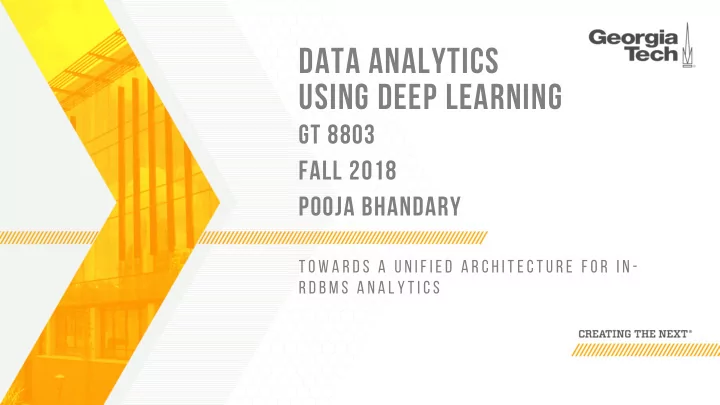

DATA ANALYTICS USING DEEP LEARNING GT 8803 FALL 2018 POOJA BHANDARY T O W A R D S A U N I F I E D A R C H I T E C T U R E F O R I N - R D B M S A N A L Y T I C S
TODAY’s PAPER • SIGMOD 2012 � In-RDBMS Analytics • Hazy project at the Department of Computer Science, University of Wisconsin, Madison. GT 8803 // Fall 2018 2
TODAY’S AGENDA • Motivation • Problem Overview • Key Idea • Technical Details • Experiments • Discussion GT 8803 // Fall 2018 3
Motivation GT 8803 // Fall 2018 4
Problem Overview • Ad hoc development cycle for incorporating new analytical tasks. • Performance optimization on a per module basis. • Limited code reusability. GT 8803 // Fall 2018 5
In-RDBMS Analytics Architecture GT 8803 // Fall 2018 6
High Level Idea • Devise a unified architecture that is capable of processing multiple data analytics techniques. • Frame analytical tasks using Convex Programming. GT 8803 // Fall 2018 7
Main Contributions • Bismarck • Identification of factors that impact performance and suggesting relevant optimizations. GT 8803 // Fall 2018 8
Bismarck GT 8803 // Fall 2018 9
Convex Optimization GT 8803 // Fall 2018 10
Gradient Descent GT 8803 // Fall 2018 11
Incremental Gradient descent • ! (#$%) = ! # − ( # )ℱ(! # , , - ) GT 8803 // Fall 2018 12
Incremental Gradient Descent • Data-access properties are amenable to an efficient in-RDBMS implementation. • IGD approximates the full gradient ∇ F using only one term at a time. GT 8803 // Fall 2018 13
Technical Approach • IGD can be implemented using a classic RDBMS abstraction called a UDA ( user-defined aggregate ). GT 8803 // Fall 2018 14
User Defined Aggregate(UDA) • Initialize • Transition • Finalize GT 8803 // Fall 2018 15
GT 8803 // Fall 2018 16
Performance Optimizations • Data Ordering • Parallelizing Gradient Computations • Avoiding Shuffling Overhead GT 8803 // Fall 2018 17
Data Ordering • Data is often clustered in RDBMSs which could lead to slower convergence time. • Shuffling at every epoch can be computationally expensive. Solution: Shuffle once GT 8803 // Fall 2018 18
Parallelizing Gradient Computations • Pure UDA - Shared Nothing Requires a merge function. Can lead to sub-optimal run time results. • Shared-Memory UDA Implemented in the user space. The model to be learned is maintained in shared memory and is concurrently updated by parallel threads. GT 8803 // Fall 2018 19
Avoiding Shuffling Overhead • Shuffling once might not be feasible for very large datasets. • Straightforward reservoir sampling could lead to slower convergence rate by discarding data items that could lead to a faster convergence. GT 8803 // Fall 2018 20
Multiplexed Reservoir Sampling • Combines the reservoir sampling idea with the concurrent update model. • Combine or multiplex, gradient steps over both the reservoir sample and the data that is not put in the reservoir buffer GT 8803 // Fall 2018 21
Multiplexed Reservoir Sampling GT 8803 // Fall 2018 22
Evaluation 1) Implement Bismarck over PostrgreSQL and two other commercial databases. 2) Compare its performance with native analytical tools provided by the RDBMSs. GT 8803 // Fall 2018 23
Tasks and Datasets 1. Logistic Regression (LR) - Forest, DBLife 2. Support Vector Machine (SVM) - Forest, DBLife 3. Low Rank Matrix Factorization (LRM) – MovieLens 4. Conditional Random Fields Labeling(CRF) - CoNLL GT 8803 // Fall 2018 24
Benchmarking Results Dataset Task PostgreSQL DBMS A DBMS B(8 segments) BISMARCK MADlib BISMARCK Native BISMARCK Native Forest LR 8.0 43.5 40.2 489.0 3.7 17.0 (Dense) SVM 7.5 140.2 32.7 66.7 3.3 19.2 DBLife LR 0.8 N/A 9.8 20.6 2.3 N/A (Sparse) SVM 1.2 N/A 11.6 4.8 4.1 N/A MovieLens LMF 36.0 29325.7 394.7 N/A 11.9 17431.3 GT 8803 // Fall 2018 25
Impact of Data Ordering GT 8803 // Fall 2018 26
Scalability Test GT 8803 // Fall 2018 27
Strengths 1. Incorporating a new task requires only a few lines of code change. 2. Shorter development cycles. 3. Performance optimization is generic. GT 8803 // Fall 2018 28
Weaknesses • Theoretical inference made about the effect of clustering on the convergence rate. • Only applies to analytical tasks that can be expressed as a convex optimization problem. GT 8803 // Fall 2018 29
Reflections GT 8803 // Fall 2018 30
References GT 8803 // Fall 2018 31
Recommend
More recommend